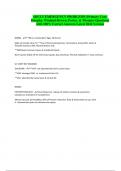ADULT EMERGENCY PROBLEMS (Primary Care,
Dunphy, Winland-Brown, Porter, & Thomas) Questions
with 100% Correct Answers Latest 2024 Version
BURNS - ✔✔**Who is Vulnerable? Ages 18-35 y/o;
Male-to-Female ratio 2:1; **Use of Oral Contraceptives, Tetracycline, Amoxicillin, Sulfa, &
Thiazide diuretics; DM, Thyroid disease, SLE;
**2ND Most Common Cause of Accidental Death;
Burn Injuries (Table 19.3)= Chemical, Liquids, Gas, Electrical, Thermal, Radiation=> most common;
UV LIGHT RAY DAMAGE/
SUN BURN - ✔✔**UVA- not absorbed by Earth's ozone layer
**UVB- damages DNA, i.e. melanoma & skin CA;
**UVC- absorbed by ozone layer & normal O2
BURNS:
PATHOPHYSIOLOGY - ✔✔Local Response: release of cellular enzymes & vasoactive
substances; Activation of complement;
Altered vascular permeability; Shift of Protein molecules, fluid, & electrolytes at cap. level
fr. intravascular space to extravascular space;
,Lymph flow increases initially, then stops due to blockage; ** >25% TBSA= Edema; **Max. Edema at 18-
24 hrs; **Systemic Response: biphasic pattern of hypofunction, followed by hyperfunction;
**Max. response w/Burns > 50% TBSA;
Hypermetabolism begins as resuscitation completes; then release of catecholamines
BURNS: RULE of 9's - ✔✔Head & Neck= 9%; Two Arms 18% (9% each); Trunk 36% (18% anter,
18% posterior); Perineum 1%; Two Legs 36% (18% each); = 100%
SUPERFICIAL BURNS
(1ST Deg.) - ✔✔Epidermal only; No blisters nor vesicles; Blanches w/Pressure; Heals in 5 d. w/o Scarring
SUPERFICIAL PARTIAL THICKNESS
BURNS (2ND Deg.) - ✔✔Epidermal Layer & Upper Layer Dermis;
Vesicles & blisters appear several hrs. after injury;
Heals w/in 21 days; minimal scarring
DEEP PARTIAL THICKNESS
BURNS (2ND Deg.) - ✔✔Epidermal Layer & most of Dermal Layer; May convert to Full-thickness; Heal
by wound contraction & epithelialization w/in 3-6 wks.
FULL-THICKNESS BURNS
(3RD Deg.) - ✔✔All Layers, down to or past SQ-fat, sometimes involves fascia, muscle & bone;
Nerves destroyed;
No pain; Skin grafting required for healing
BURNS: DIAGNOSTICS - ✔✔LABS: CBC, Lytes, BUN/Cr, Gluc; P.Oxm'ty; ABG's;
Carboxyhemoglobin (COHb) Level;
** <10% = no SX's; ** 20% = H/A, N & V, Loss of Dexterity; **30% = confusion, Lethargy, ST-seg.
depression; **40-60% = coma; ** >60% = Death
, MAJOR BURNS:
MANAGEMENT - ✔✔EMERGENCY MANGMT: MAJOR BURNS =
Transfer to Burn Center if: 1) Partial-thickness burn:
>25% of TBSA in person 10-50 y/o OR >20% TBSA in person <10 or >50 y/o; 2) Full-thickness burn
>10% TBSA in anyone; 3) Serious burn involving hand, face, foot, or perineum; 4) Burn complicated by
inhalation injury; 5) Electrical burn; 6) Any burn in Infant or Immunocompromised/Elderly person
MINOR BURNS:
MANAGEMENT - ✔✔<15% TBSA in Individuals 10-50 y/o; <10% in child <10 y/o or adult >50 y/o; **
1ST Deg.=
Cooled w/ wet compresses, aloe vera gel, Ibuprofen 800mg; PO Prednisone if severe; rapid taper over 5
d.; **2ND Deg.= Irrigate w/cool water/saline soln. to remove loose skin & dirt;
Sm. thick blisters = Leave intact; Thin, fluid-filled blisters >1 in. diam.= Drain, trim off dead skin;
Top. Antimicrobial Crm. (Silvadene = best choice; NOT for Sulfa allergies nor facial burns);
Top. Antimicrobial for FACE: Neosporin, Bacitracin, or Ophthalmic Gentamicin ointment; **Dressing:
change BID x 7-10 d.; Xeroform Gauze may be used (w/o top. antimicrobial) - check wound next day;
Oral ABX only if burn becomes infected; Tetanus Vaccine = ANY infected wound.
BURNS: PT. EDUC - ✔✔Elevate burned area; Return to Office if signs of infection; Avoid PABA
sunscreens; Use broad-spectrum; Notify office if Fever & Pain persistent for > 48 hrs.; **Be aware of UV
Index = 0-2 Minimal., 3-4 Low, 5-6 Modt., 7-9 High, 10+ Very High; Use lip balm with sunscreen;
Minimize exposure to sun when sun directly overhead; Wear sunglasses blocking 99-100% UV radiation
Animal & Human Bites - ✔✔All bites = considered contaminated; have great risk for infection; **Dog
bites = 5% infection rate; bite to Hand = 40% infection rate; **Cat bites = 50% infection rate; can
develop w/in 24 hrs.; **Human Bites: **Low-risk Wounds = Lacerations: extremities, face, ears, scalp,
mouth, body; **High-risk Wounds = hand, wrist, foot, scalp of infant, wound over joint, penetrating
wound of cheek
ANIMAL & HUMAN BITES: CC,
HX & Physical Examination - ✔✔SUBJ: determine circumstances of bite; ask about Tetanus
status, allergies, occupation, immunologic status
OBJ: Skin, Vascular, ROM, Motor & sensory functions, Skeletal injury, Assess for infection




